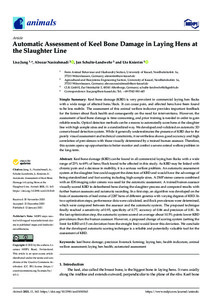| dc.date.accessioned | 2021-03-12T11:42:58Z | |
| dc.date.available | 2021-03-12T11:42:58Z | |
| dc.date.issued | 2021-01-12 | |
| dc.identifier | doi:10.17170/kobra-202103093464 | |
| dc.identifier.uri | http://hdl.handle.net/123456789/12626 | |
| dc.description.sponsorship | Gefördert durch den Publikationsfonds der Universität Kassel | ger |
| dc.language.iso | eng | eng |
| dc.rights | Namensnennung 4.0 International | * |
| dc.rights.uri | http://creativecommons.org/licenses/by/4.0/ | * |
| dc.subject | keel bone damage | eng |
| dc.subject | precision livestock farming | eng |
| dc.subject | laying hen | eng |
| dc.subject | health indicators | eng |
| dc.subject | animal welfare assessment | eng |
| dc.subject | laying hen health | eng |
| dc.subject | automated assessment | eng |
| dc.subject.ddc | 590 | |
| dc.title | Automatic Assessment of Keel Bone Damage in Laying Hens at the Slaughter Line | eng |
| dc.type | Aufsatz | |
| dcterms.abstract | Simple Summary
Keel bone damage (KBD) is very prevalent in commercial laying hen flocks with a wide range of affected hens/flock. It can cause pain, and affected hens have been found to be less mobile. The assessment of this animal welfare indicator provides important feedback for the farmer about flock health and consequently on the need for interventions. However, the assessment of keel bone damage is time-consuming, and prior training is needed in order to gain reliable results. Optical detection methods can be a means to automatedly score hens at the slaughter line with high sample sizes and in a standardized way. We developed and validated an automatic 3D camera-based detection system. While it generally underestimates the presence of KBD due to the purely visual assessment and technical constraints, it nevertheless shows good accuracy and high correlation of prevalences with those visually determined by a trained human assessor. Therefore, this system opens up opportunities to better monitor and combat a severe animal welfare problem in the long-term.
Abstract
Keel bone damage (KBD) can be found in all commercial laying hen flocks with a wide range of 23% to 69% of hens/flock found to be affected in this study. As KBD may be linked with chronic pain and a decrease in mobility, it is a serious welfare problem. An automatic assessment system at the slaughter line could support the detection of KBD and would have the advantage of being standardized and fast scoring including high sample sizes. A 2MP stereo camera combined with an IDS imaging color camera was used for the automatic assessment. A trained human assessor visually scored KBD in defeathered hens during the slaughter process and compared results with further human assessors and automatic recording. In a first step, an algorithm was developed on the basis of assessments of keel status of 2287 hens of different genetics with varying degrees of KBD. In two optimization steps, performance data were calculated, and flock prevalences were determined, which were compared between the assessor and the automatic system. The proposed technique finally reached a sensitivity of 0.95, specificity of 0.77, accuracy of 0.86 and precision of 0.81. In the last optimization step, the automatic system scored on average about 10.5% points lower KBD prevalences than the human assessor. However, a proposed change of scoring system (setting the limit for KBD at 0.5 cm deviation from the straight line) would lower this deviation. We conclude that the developed automatic scoring technique is a reliable and potentially valuable tool for the assessment of KBD. | eng |
| dcterms.accessRights | open access | |
| dcterms.creator | Jung, Lisa | |
| dcterms.creator | Nasirahmadi, Abozar | |
| dcterms.creator | Schulte-Landwehr, Jan | |
| dcterms.creator | Knierim, Ute | |
| dc.relation.doi | doi:10.3390/ani11010163 | |
| dc.subject.swd | Legehenne | ger |
| dc.subject.swd | Knochenverletzung | ger |
| dc.subject.swd | Tiergesundheit | ger |
| dc.subject.swd | Präzisionslandwirtschaft | ger |
| dc.subject.swd | Legehennenhaltung | ger |
| dc.subject.swd | Gesundheitsindikator | ger |
| dc.subject.swd | Automatisches Prüfen | ger |
| dc.type.version | publishedVersion | |
| dcterms.source.identifier | EISSN 2076-2615 | |
| dcterms.source.issue | Issue 1 | |
| dcterms.source.journal | Animals | eng |
| dcterms.source.volume | Volume 11 | |
| kup.iskup | false | |
| dcterms.source.articlenumber | 163 | |


